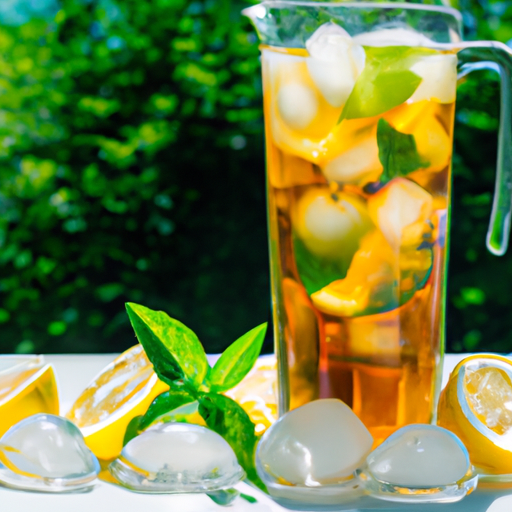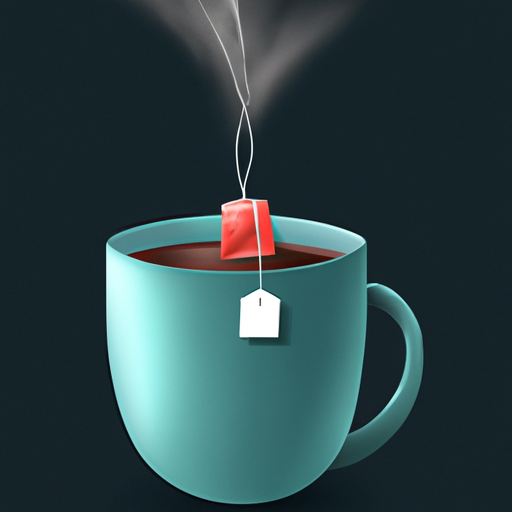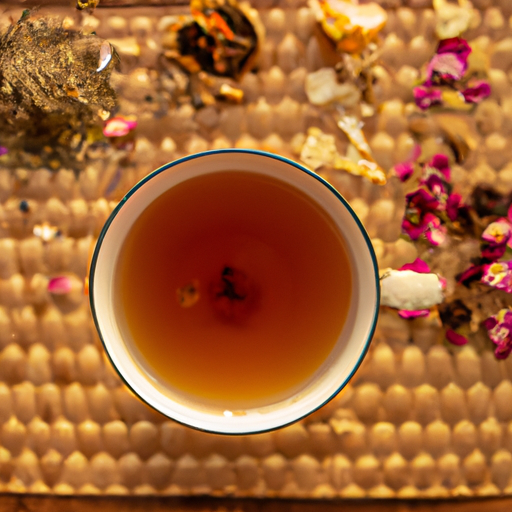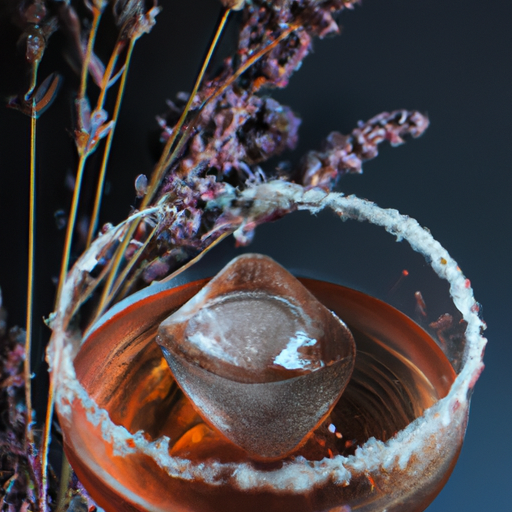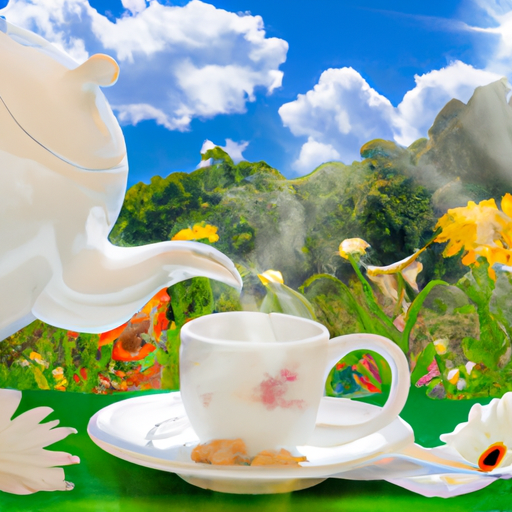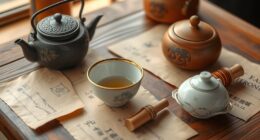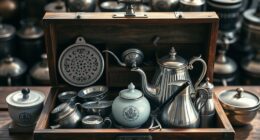As I sit here sipping on my favorite cup of tea, I can’t help but marvel at the vast array of flavors and benefits that come from this magical beverage. Tea has been a beloved drink for centuries, with its origins dating back to ancient China. But what about herbal tea? How does it differ from traditional tea?
Imagine walking through a lush garden, surrounded by vibrant flowers and fragrant herbs. Each plant holds its own unique properties and flavors, just waiting to be discovered. That’s the world of herbal tea – a delightful concoction made from the infusion of various plants, excluding the leaves of the Camellia sinensis plant, which is used to make traditional tea.
But the differences don’t stop there. From the processing methods to the flavor profiles, the caffeine content to the health benefits, tea and herbal tea each have their own distinct qualities.
Join me as we dive deeper into the fascinating world of tea and herbal tea, exploring their origins, characteristics, and cultural significance. Grab a cup and let’s embark on this flavorful journey together.
Key Takeaways
- Tea is made from the Camellia sinensis plant and undergoes fermentation and oxidation, while herbal tea is made from dried flowers, leaves, seeds, or roots of various plants and is processed through drying and steeping.
- Different levels of oxidation give green, oolong, and black tea their distinct flavors, while herbal tea flavors include mint, chamomile, and citrus.
- Traditional tea contains caffeine, while herbal tea is caffeine-free, although herbal teas may contain minimal caffeine.
- Tea contains antioxidants that protect against free radicals, while different herbal teas have specific health benefits such as chamomile for sleep, peppermint for digestion, ginger for inflammation, rooibos for antioxidants and heart health, and hibiscus for vitamin C and blood pressure.
The Origins of Tea and Herbal Tea
Did you know that the origins of tea and herbal tea are as fascinating as the flavors they offer? Tea, made from the leaves of the Camellia sinensis plant, originated in China over 5,000 years ago. It quickly gained popularity for its refreshing taste and invigorating effects.
On the other hand, herbal tea, also known as tisane, is made from dried flowers, leaves, seeds, or roots of various plants. It has been enjoyed for centuries across different cultures for its therapeutic properties and unique flavors.
Tea and herbal tea can be prepared in different ways. Tea leaves are typically dried, rolled, and then steeped in hot water. The oxidation level of the leaves determines the type of tea, whether it be black, green, oolong, or white. Each type offers a distinct flavor profile and health benefits.
Herbal tea, on the other hand, is prepared by steeping the plant material in hot water without any oxidation process. This method allows the natural oils and compounds of the plants to infuse into the water, creating a flavorful and aromatic drink.
Now, let’s delve into the processing methods that further distinguish tea and herbal tea.
The Processing Methods
When it comes to processing tea, fermentation and oxidation are key steps that contribute to its flavor and aroma. During fermentation, the tea leaves are exposed to air, which triggers chemical reactions that give tea its distinct taste.
On the other hand, herbal tea is processed through drying and steeping. Drying helps to preserve the natural flavors and aromas of the herbs, while steeping in hot water allows these flavors to be extracted and enjoyed in a warm cup of herbal tea.
Fermentation and oxidation for tea
During the fermentation and oxidation process, tea leaves undergo chemical changes that result in a complex and robust flavor profile, making it the perfect beverage to sip and savor. The fermentation process involves allowing the tea leaves to wilt slightly and then exposing them to heat and moisture, which triggers enzymatic reactions. This process breaks down the polyphenols in the leaves and allows them to interact with oxygen, leading to oxidation. As a result, the tea leaves darken and develop a rich flavor. The level of oxidation can vary depending on the type of tea being produced. To illustrate this, here is a table showcasing the different levels of oxidation for various types of tea:
| Type of Tea | Level of Oxidation |
|---|---|
| Green Tea | Minimal |
| Oolong Tea | Partial |
| Black Tea | Fully |
As the fermentation and oxidation process concludes, the tea leaves are then ready for the next step, which involves drying and steeping for herbal tea.
Drying and steeping for herbal tea
After the fermentation and oxidation process, it’s time to dry and steep the tea leaves to create a delightful and aromatic herbal infusion.
The drying methods used for herbal tea are crucial in preserving the flavors and nutrients of the leaves. The most common drying method is air drying, where the leaves are spread out and left to dry naturally. Another method is oven drying, which involves using low heat to remove moisture from the leaves. Lastly, some teas are freeze-dried, a process that involves freezing the leaves and then removing the moisture through sublimation.
Once the leaves are dried, they’re ready for steeping. Steeping techniques for herbal tea vary depending on the type of tea and desired flavor profile. For lighter teas, such as chamomile or mint, a shorter steeping time of around 3-4 minutes is recommended to avoid a bitter taste. Stronger herbal teas, like hibiscus or ginger, can be steeped for 5-7 minutes for a more robust flavor.
Transitioning to the subsequent section about flavor profiles, the drying and steeping processes greatly influence the taste and aroma of herbal teas.
The Flavor Profiles
If you’re looking for a burst of natural flavors, herbal tea is like a symphony of taste, while traditional tea dances on your taste buds with its rich, complex notes.
The flavor profiles of herbal tea are diverse and cater to a wide range of flavor preferences. Whether you enjoy the refreshing taste of mint, the soothing aroma of chamomile, or the zesty tang of citrus, there’s an herbal tea out there for everyone.
The brewing techniques for herbal tea also allow for customization to suit individual tastes. You can adjust the steeping time and temperature to bring out the optimal flavors and create a personalized experience.
Herbal teas are a great option for those who want to explore different flavor combinations and experiment with their brewing techniques. The absence of caffeine in most herbal teas allows for unlimited consumption throughout the day, without the risk of jitters or sleep disturbances.
However, if you’re someone who enjoys the energizing effects of caffeine, traditional tea might be more suitable for you.
In the next section, we’ll dive into the caffeine content of tea and herbal tea, and how it can impact your daily routine.
The Caffeine Content
Tea and herbal tea differ in terms of their caffeine content. As a tea lover, I appreciate the natural boost that caffeine provides. Traditional tea, such as black, green, and oolong, contains caffeine, while herbal tea is caffeine-free.
This distinction allows individuals to choose a beverage that aligns with their energy needs and preferences.
Tea contains caffeine
Although herbal tea may seem like a healthier alternative, it still contains caffeine. Many people assume that herbal tea is caffeine-free, but this is not the case. Tea, including herbal tea, is made from the leaves of the Camellia sinensis plant, which naturally contains caffeine.
The caffeine content in tea can vary depending on factors such as the type of tea, the brewing time, and the water temperature. Here are some interesting facts about the caffeine content in different types of tea:
- Black tea generally has the highest caffeine content among all teas.
- Green tea contains less caffeine than black tea but still provides a moderate amount.
- White tea has the least amount of caffeine among all teas.
- Herbal teas, such as chamomile or peppermint, may have minimal amounts of caffeine, but it can still have an impact on sensitive individuals.
Understanding the effects of caffeine on the body and the varying caffeine content in different teas is important for making informed choices about your tea consumption.
Transitioning into the next section, it’s worth noting that herbal tea is caffeine-free.
Herbal tea is caffeine-free
While herbal tea is often seen as a soothing and caffeine-free option, it can still surprise you with a subtle jolt of energy. Unlike traditional tea, which is derived from the leaves of the Camellia sinensis plant, herbal tea is made by steeping various herbs, flowers, and spices.
The processing methods for herbal tea differ greatly from those used for regular tea, resulting in a distinct flavor profile. Some popular herbal teas include chamomile, peppermint, and hibiscus, each offering its own unique taste and aroma.
Despite the absence of caffeine, herbal teas can provide a natural boost due to the herbs’ inherent properties. These teas are known for their calming effect on the body and mind, making them an excellent choice for relaxation.
Additionally, herbal teas offer a range of health benefits, which will be discussed in the next section.
The Health Benefits
When it comes to the health benefits of tea, there are two key points to consider. First, tea contains antioxidants that can help protect the body from damage caused by free radicals.
Second, different types of herbal teas offer a variety of health benefits, such as boosting the immune system, aiding digestion, and promoting relaxation.
Overall, incorporating tea into your daily routine can be a great way to support your overall health and well-being.
Antioxidants and potential health benefits of tea
Did you know that tea isn’t just a delicious beverage, but it also contains antioxidants that can potentially benefit your health?
Antioxidants are compounds that help protect our cells from damage caused by harmful free radicals. Tea, especially green tea, is rich in antioxidants called catechins. These catechins have been linked to various health benefits, including reducing the risk of heart disease, improving brain function, and even aiding in weight loss.
Additionally, the antioxidants in tea may help lower the risk of certain types of cancer. The potential health benefits of herbal tea may vary depending on the specific herbs used. However, many herbal teas also contain antioxidants that can contribute to overall well-being.
Transitioning to the next section, let’s explore the various herbal teas and their associated health benefits.
Various herbal teas and their associated health benefits
Let’s explore the health benefits of different herbal teas and see if they live up to the claims.
Herbal tea varieties offer a wide range of benefits, each containing its own unique properties.
Chamomile tea, for example, is known for its calming effects and ability to improve sleep quality.
Peppermint tea can help with digestion and alleviate symptoms of irritable bowel syndrome.
Ginger tea has anti-inflammatory properties and can aid in relieving nausea and reducing muscle pain.
Rooibos tea is rich in antioxidants and may lower blood pressure and improve heart health.
Hibiscus tea is packed with vitamin C and may help lower blood pressure and cholesterol levels.
These herbal tea benefits are just the tip of the iceberg when it comes to the potential health advantages they offer.
Moving forward, let’s delve into the cultural significance of tea.
The Cultural Significance
Tea and herbal tea differ in their cultural significance, highlighting the importance of tradition and cultural practices.
Cultural traditions associated with tea have been deeply rooted in various societies for centuries. In countries like China, Japan, and the United Kingdom, tea ceremonies are not just a way to enjoy a warm beverage, but they also symbolize hospitality, respect, and harmony. These ceremonies have become an integral part of their cultural identity, reflecting the values and beliefs of these societies.
Herbal teas, on the other hand, have their own cultural significance. They have been used for centuries as natural remedies for various health conditions. Different cultures have their own traditional herbal teas that are believed to possess medicinal properties. For example, in Indian Ayurvedic tradition, tulsi tea is highly regarded for its immune-boosting and stress-relieving properties. Similarly, in traditional Chinese medicine, chrysanthemum tea is known for its cooling and detoxifying effects.
Transitioning into the subsequent section about popular varieties and blends, it’s fascinating to explore the wide array of tea options available today. From the classic black and green teas to the more exotic fruit-infused blends, there’s a tea for every taste and preference.
Popular Varieties and Blends
When it comes to popular varieties and blends of tea, there are a few key players that come to mind. Green, black, oolong, and white teas are all well-known and widely enjoyed for their unique flavors and health benefits.
On the herbal tea side, chamomile, peppermint, rooibos, and other blends offer a refreshing and soothing alternative to traditional teas.
Each variety and blend has its own distinct characteristics, making the world of tea a diverse and exciting one to explore.
Green, black, oolong, and white teas
Green, black, oolong, and white teas offer a diverse range of flavors and health benefits. Green tea, in particular, is known for its numerous health benefits. It’s rich in antioxidants and can help boost metabolism and promote weight loss.
Black tea, on the other hand, is more oxidized and has a stronger flavor compared to green tea. Although both types come from the same plant, their processing methods differ, resulting in distinct flavors and properties.
Oolong tea is partially oxidized and has a unique taste that falls between green and black tea.
White tea is the least processed and has a delicate flavor with subtle floral notes. These teas are all derived from the Camellia sinensis plant and provide a wide range of options for tea enthusiasts.
Moving on to chamomile, peppermint, rooibos, and other herbal tea blends…
Chamomile, peppermint, rooibos, and other herbal tea blends
Indulge yourself in the soothing and invigorating world of herbal tea blends, where chamomile, peppermint, rooibos, and other delightful flavors will transport you to a realm of pure relaxation and bliss.
-
Chamomile: Known for its calming properties, chamomile tea can help reduce anxiety and promote better sleep. It also has anti-inflammatory and antioxidant effects, which can benefit overall health.
-
Rooibos: This South African herbal tea is caffeine-free and rich in antioxidants. It’s known for its sweet and nutty flavor, making it a popular choice for those seeking a caffeine-free alternative. Rooibos tea may also have potential health benefits, such as improving digestion and supporting heart health.
-
Peppermint: Refreshing and minty, peppermint tea is known for its soothing effects on the digestive system. It can help relieve indigestion, bloating, and nausea. Additionally, peppermint tea has a cooling effect, making it a perfect choice for hot summer days.
Explore the world of herbal tea blends and discover the unique flavors and health benefits they offer. Enjoy a cup of chamomile or rooibos tea for relaxation, or savor the invigorating taste of peppermint tea for a refreshing experience.
Frequently Asked Questions
Can herbal tea be considered a true tea?
Herbal tea is not considered a true tea because it is not made from the Camellia sinensis plant. However, herbal teas offer their own health benefits such as soothing properties, antioxidant content, and potential for relaxation.
Is there a specific type of tea that is more beneficial for health?
There is no specific type of tea that is more beneficial for health as all teas have their own specific health benefits. Additionally, different teas have different flavor profiles, allowing for a variety of tastes and preferences.
How does the caffeine content in tea and herbal tea compare to coffee?
The caffeine content in tea and herbal tea is generally lower than that of coffee. While the exact amount varies, tea and herbal tea provide a milder caffeine boost compared to coffee.
Are there any potential side effects or risks associated with drinking tea or herbal tea?
There are potential side effects and risks associated with drinking tea or herbal tea. It’s important to be aware of the recommended daily intake and any potential health benefits before consuming them.
Can both tea and herbal tea be enjoyed hot and cold, or are there specific preferences for each?
Both tea and herbal tea can be enjoyed hot or cold, it depends on personal taste preferences. Some people prefer hot tea for its comforting warmth, while others enjoy herbal tea cold for its refreshing qualities.
Conclusion
In conclusion, understanding the difference between tea and herbal tea is crucial for tea enthusiasts.
Tea comes from the Camellia sinensis plant and undergoes processing to create different varieties.
On the other hand, herbal tea is made from a variety of plants and herbs.
One interesting statistic is that herbal tea consumption is on the rise.
A 2019 study showed that 87% of tea drinkers in the United States have tried herbal tea.
Knowing the distinctions in flavor, caffeine content, and health benefits can enhance our enjoyment and appreciation of these beloved beverages.


